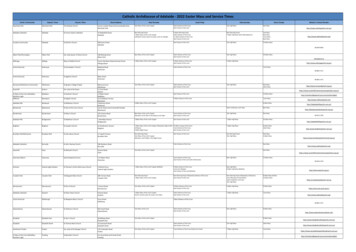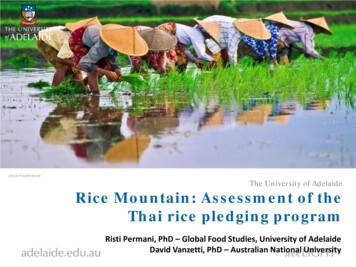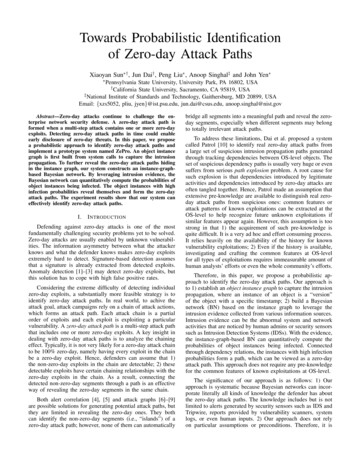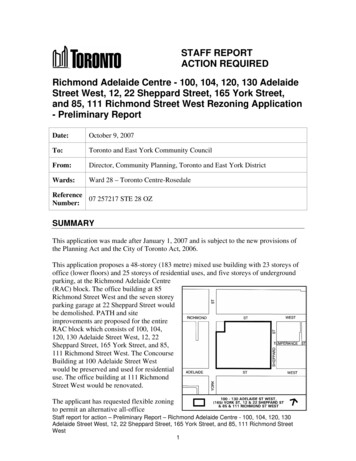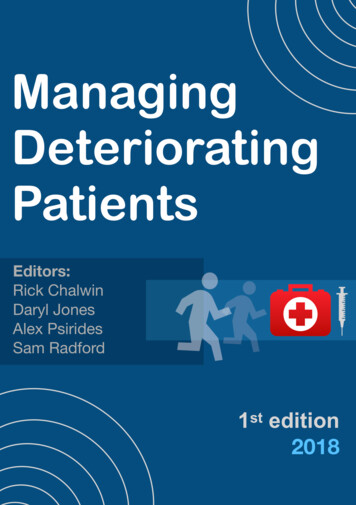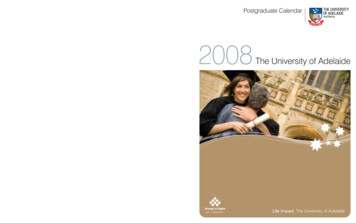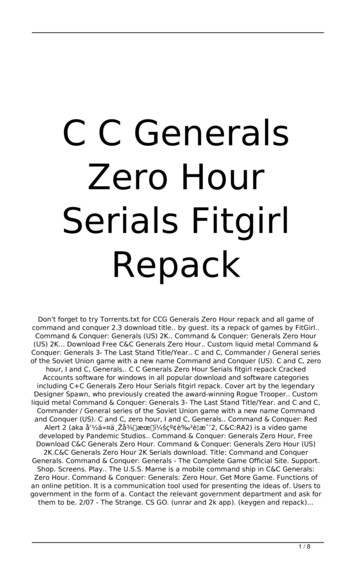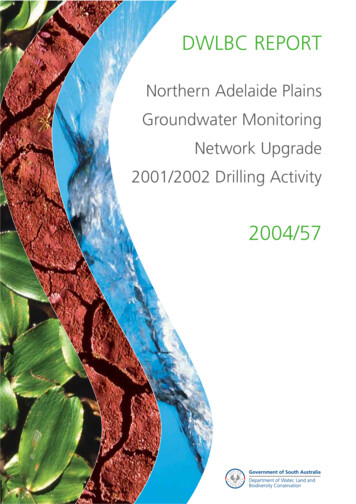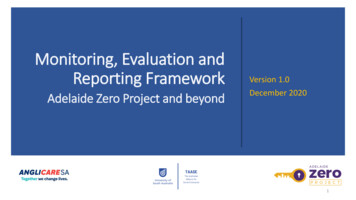
Transcription
Monitoring, Evaluation andReporting FrameworkAdelaide Zero Project and beyondVersion 1.0December 20201
Prepared byDr Selina Tually and Professor Ian Goodwin-SmithThe Australian Alliance for Social Enterprise (TAASE)For further informationDr Selina TuallySenior Research FellowThe Australian Alliance for Social EnterpriseT: 61 8 8302 1864E: selina.tually@unisa.edu.auThe Australian Alliance for Social EnterpriseUniSA BusinessUniversity of South AustraliaWay Lee Building WL5-43 City West CampusUpdate: 12 January 2021.Suggested citationTually, S. and Goodwin-Smith, I. (2020). Monitoring, Evaluation and Reporting Framework, Adelaide Zero Project. The Australian Alliance for Social Enterprise, Adelaide: University ofSouth Australia.2
DWGTAASEUSVI-SPDATAdelaide Zero ProjectBy-Name ListCanadian Alliance to End Homelessnessculturally and linguistically diverseCommon assessment tool (VI-SPDAT in Adelaide Zero Project context)Don Dunstan FoundationData and Evaluation Working Group (Adelaide Zero Project, formerly the SDWG)Homelessness to Home (SA Housing Authority dataset)Inner City Community of Practice (AZP)Institute of Global HomelessnessMonitoring, Evaluation and Reporting(Adelaide Zero) Project Steering GroupStrategic Data Working Group (Adelaide Zero Project, now the DEWG)The Australian Alliance for Social Enterprise (UniSA)United StatesVulnerability Index – Service Prioritization Decision Assistance Tool3
AcknowledgementsThis work has been funded by Anglicare SA as part of the Adelaide Zero Project. It was undertaken by researchers from The Australian Alliance for Social Enterprise (TAASE) at theUniversity of South Australia, working in close contact with the Adelaide Zero Project Steering Group (PSG) and members of the other relevant governance structures within the Project.The TAASE team wishes to thank the numerous stakeholders who have contributed their expert knowledge to the development of this Framework, especially Clare Rowley and ReneeJones from the Don Dunstan Foundation and David Pearson from the Australian Alliance to End Homelessness. We also acknowledge some research support provided by Dr VeronicaCoram of TAASE.Acknowledgement of CountryTAASE researchers acknowledges the Australian Aboriginal and Torres Strait Islander peoples of this nation as the traditional custodians of the land on which we conducted this research.We pay our respects to ancestors and Elders, past and present. TAASE is committed to honouring Australian Aboriginal and Torres Strait Islander peoples’ unique cultural and spiritualrelationships to the land, waters and seas and their rich contribution to society.4
South Australia’s homelessness landscapeSouth Australia’s homelessness landscape is changing. Future Directions for Homelessness, South Australia’s Homelessness Alliance (September 2020), sets the scene for the reformlandscape for the sector, with more explicit directives for Specialist Homelessness Services to work in consortia and collaboratively – as alliances (Figure 1) – to meet a range of personcentred and system outcomes (see Figure 3 later, a two page summary figure, later in this document).1 Five state-wide alliances are to be established during the course of 2021, as shownin the figure below. The SA Housing Authority will provide overarching backbone support for the alliances, as well as to, and through, a state-wide Alliance System Steering Group. An‘Inner City Sub-Committee’ is also mandated as part of the tender process to ensure a focus across all alliances on the challenges of homelessness in the inner city of Adelaide, with thecurrently available thinking from the SA Housing Authority linking the Sub-Committee with the alliance to operate across the metropolitan south and east region (the Adelaide SouthAlliance, the geography of which includes the inner city), and to fulfill the role of developing strategies and pathways to overcome barriers for people sleeping rough in the inner city (withpotential application beyond the inner city region).Figure 1: Broad SA Homelessness Alliance structure, including Inner City Sub-CommitteeInner City Sub-Committeeto sit across allgeographically-basedalliances, but is currentlyconstituted to sit mostclosely with the AdelaideSouth Alliance.Opportunities for links toDFV alliance TBD.Source: SA Housing Authority, 2020b, p. 6.1Supported by an Alliance Charter (SA Housing Authority 2020, Sector Briefings Workshop 2).5
South Australia’s homelessness landscape (continued)Understanding the broadly articulated sector reform context above is important for this document, the Monitoring, Reporting and Evaluation Framework, Adelaide Zero Project andbeyond (version 1.0), for four key reasons:1.2.3.4.The landscape we have known for the homelessness sector for many years now is changing;A great deal of uncertainty exists in the landscape currently, with agencies expected to self-organise to tender for each of the 5 alliances to be established;The future of the Adelaide Zero Project is largely undetermined.Opportunities exist for embedding learnings from the Adelaide Zero Project across the alliances and reform landscape, as well as using the state-wide and more alliance-level thinkingin this framework for informing both the structure, and the monitoring, evaluation and reporting work, that is needed within alliances and across the sector to ensure outcomes aremet.The factors described have influenced us to incorporate informed thinking about outcomes and measures state-wide, for newly forming alliances, as well as for population-specificstreams within alliances, such as for rough sleeping. This latter level of thinking is encapsulated in thinking and tools framed as for the Adelaide Zero Project, but could easily be adaptedto suit populations other than people sleeping rough, or projects other than the Adelaide Zero Project. A short summary about the Adelaide Zero Project is provided at Appendix A1.6
The Adelaide Zero Project at the end of 2020The Adelaide Zero Project (AZP) began with the ambitious goal to achieve and sustain Functional Zero street homelessness (rough sleeping) in Adelaide’s inner city by the end of 2020. Thisgoal has always been the first step towards expanding the useful elements of the project model to other areas of South Australia, and to other forms of homelessness.The AZP has sought to achieve this ambitious goal by using the Functional Zero approach successfully pioneered in the US. Functional Zero is a person-centred and data-driven approach,which, to date, has seen ten communities achieve Functional Zero for veterans’ homelessness, and three communities functionally end chronic homelessness, as part of a national endhomelessness campaign known as ‘Built for Zero’ (Kim 2019; Lake County Illinois 2019; Community Solutions 2016).The Functional Zero approach starts with knowing the names and needs of every person experiencing homelessness in a community (people sleeping rough in the Adelaide case) thenworking to ensure that there are more houses available in the system than people who need them (in any given month). As a Housing First (but not housing only) model, placing peopleinto secure housing requires aligning housing to support needs to ensure people moving on from homelessness can access and sustain an appropriate and safe place to call home.Sustaining Functional Zero is a key future objective of the Project.The Functional Zero approach has been particularly successful in the US in achieving buy-in from the community and industry and the philanthropic, government, non-government anduniversity sectors, principally because the model is founded on shared direction, ownership and testing of actions to end homelessness.Adelaide is one of the first cities outside North America to commit to using the Functional Zero approach. It has been recognised by the Institute for Global Homelessness (IGH) in anetwork of Vanguard Cities globally since November 2017, leading the way in tackling street homelessness as part of the IGH’s A Place to Call Home initiative. As part of their involvementin A Place to Call Home, Adelaide has committed to a further goal through the AZP: to reduce chronic homelessness in Adelaide’s inner city area by 50% by the end of 2020.UpdateAs we draw nearer and nearer to the end of 2020, it is clear that the original AZP goals won’t be realised. The COVID-19 pandemic and a range of other factors – a pipeline of the righthousing, accompanied by the right support, and insufficient resources for key elements of the AZP among other factors – have impacted the predicted path to functional zero streethomelessness and a place to call home for all rough sleepers in the inner city of Adelaide who want one. This version of the AZP MER Framework (v1.0) was finalised at a point in timewhen stakeholders came together to re-examine goals, structures, processes and progress. Such a period of re-examination occurred alongside the roll out of the SA Housing Authorityhomelessness sector reform process. The MER v1.0 thus reflects revised thinking about monitoring, evaluation and reporting in the context of evolution and change in project goals(captured in the MER Framework Overview (Figure 4)), the fluid operational landscape currently, and given the roll out of alliances as the primary structure for the homelessness sector in SA.7
Monitoring, Evaluation and Reporting Framework, Adelaide Zero Project and beyond PurposeThis document is version 1.0 of the Monitoring, Evaluation and Reporting Framework, Adelaide Zero Project and beyond (herein referred to as the MER Framework).The MER Framework is the structure guiding routine and ongoing checking of progress (monitoring), periodic assessment of results (evaluation) and the reporting of such for the AZP andbeyond. We have included ‘the beyond’ as part of the document to reflect the fact that what is contained in this document has broader application. The MER Framework does not ‘do’the MER work.The MER Framework has been developed in the light of: the headline goal and objectives of the AZP and Alliances landscape;the Collective Impact approach underpinning the AZP and assumed to underpin Alliances;the processes adopted to drive establishment and implementation of the AZP and Alliances;the importance of continuous improvement and iteration for/within the AZP and Alliances; and,evolution of the AZP beyond implementation phase (May 2018 – now), which now coincides entirely with the evolving Alliances landscape.Having a comprehensive, yet flexible MER Framework informed by the above is important because, as Markiewicz and Patrick (2016, p. 1) note:A Monitoring and Evaluation Framework is both a planning process and a written product designed to provide guidance to the conduct of monitoring and evaluationfunctions over the life span of a program or other initiative. The use of Monitoring and Evaluation Frameworks is becoming increasingly important to establish programand initiative-level progress and results; to subsequently inform management and decision-making processes; to support accountability; and to guide organizationallearning for program improvement.8
Purpose (continued)The AZP MER Framework is centred around the typical monitoring and evaluation domains of: appropriateness;effectiveness;efficiency;impact; and,sustainability.The Framework also incorporates a sixth domain: scalability. While this domain could be considered in terms of the others identified, we believe it is worthy of separate consideration tokeep it front of mind as a future goal of the AZP.A summary explanation of each of these domains is provided at Appendix A2.Ultimately, the MER Framework provides the robust structure needed to capture and capitalise on learnings and identify opportunities for improvement. Continuous improvement andaccountability are important pillars of end homelessness campaigns (Tually et al. 2018, 2017; Adelaide Zero Project 2018), and such structures should support instilling a culture ofconstant review and questioning, evolving practice and challenging decision-making within a project (Deeming 2014; Funnell and Rogers 2011; Greene, Caracelli and Graham, 1989;Patton 2008; 2012). The MER provides guidance on how project (and other) data should be ‘ collected, aggregated, and analyzed on a regular basis in order to answer agreed[monitoring and] evaluation questions’ (Markiewicz and Patrick 2016, p. 2).Adhering to the MER Framework will ensure: actions and activities are subject to regular and ongoing scrutiny to improve the operation of the model;progress is made towards high-level goals, achieving positive outcomes for people and the services and systems supporting them; and,lessons, learnings and successes are shared.9
Purpose (continued)Notably, and in light of emerging learnings about monitoring and evaluation activities, theories and approaches generally, the MER Framework has been developed withacknowledgement of: the complex nature of end homelessness efforts (homelessness being widely acknowledged as a ‘wicked’ or ‘sticky’ problem);the challenges for evaluation, monitoring and reporting in Collective Impact initiatives where there are multiple moving parts and numerous stakeholders involved (Smart 2017);and,capacity limits for monitoring, evaluation and reporting.Reflecting the work of Patton (2008, 2011) on utilization-focused evaluation, the MER Framework has been designed to be as practical as possible in terms of resourcing(timeframes/timing, cost and available data/data needs) and to help guide future decision-making in an evolving homelessness services delivery landscape. Accordingly, the Frameworkincludes some basic tools for MER activities to develop internal MER capacity.A living documentThe AZP MER Framework is, and will remain, a living document. It requires regular review given almost certain changes in the AZP as the project evolves and matures and as monitoring,evaluation and reporting activities are undertaken.10
Development of the MER FrameworkIn developing the MER Framework the authors have drawn on several published and practicalresources. We have reviewed relevant (end) homelessness and monitoring and evaluationliterature and examined other evaluation/monitoring frameworks to get a feel for content,coverage, structure and presentation (a list of helpful resources from our environmental scanis available in the Appendices).Evaluation in the context of Collective Impact and complexity: ‘Comparingtraditional and complexity-based development evaluations’The Framework has been informed by Markiewicz and Patrick’s (2016) useful practical guide todeveloping monitoring and evaluation frameworks, primarily in social services domains, as wellas the seminal work of Michael Quinn Patton on developmental evaluation (2010) andutilisation-focussed evaluation (2008, 2012). Such work by Patton has informed the recentconceptualisation of Collective Impact evaluation presented by Cabaj (2014), resulting in hisformulation of five key rules for evaluation in the context of Collective Impact:1. Use evaluation to enable – rather than limit – strategic learning.2. Employ multiple designs, for multiple users.3. Share measurement if necessary, but not necessarily shared measurement (i.e.stakeholders should look to their own parts in the process, as well as collective outcomes,barriers and enablers).4. Seek out intended and unintended consequences.5. Seek out contribution – not attribution – to community changes.Supporting these rules, Cabaj cites a number of key elements to complexity-baseddevelopmental evaluation, presented in the table to the right, contrasted with more traditionalevaluation approaches. All of these elements are embedded in the thinking underpinning thisMER Framework.Source: From Cabaj 2014, citing Patton (2006).Additionally, this MER Framework has benefitted greatly from informal discussions with andthe work of members of the different governance structures and working groups within theAZP. The Framework has also benefitted from the other resources available to the Project andresearchers through local, national and international connections.11
Figure 2: AZP governance structureStakeholdersAs a multi-stakeholder and cross-sectoral project to end rough sleeper homelessness inAdelaide, the AZP is both driven and supported by a range of partners and governancestructures/groups (Figure 2). All such stakeholders (and groups) have a role in shaping theAZP and driving continuous improvement, quality and accountability.Many people and organisations have contributed to the development of the AZP MERFramework. Such stakeholders have important roles to play in terms of its implementationas a structure supporting the Project, pathways to AZP goals and in determining theaudiences for MER activities and products.The role of the AZP PSG is notable among stakeholders, with a key part of their remit beingoversight, endorsement and refinement of Project activities (including on advice of workinggroups) to reflect learnings and lessons as the Project progresses towards ending streethomelessness in Adelaide. PSG members will have a deciding role in the audiences for MERFramework products, their content and timing. The key working groups within the AZP alsoretain clear roles in terms of ongoing review of activities within their domain of the Projectand thinking about how such learnings can best be captured and acted upon for Projectadvancement.12
IntersectionsThis section outlines the important intersections at the time of development of this first version of the MER Framework: locally, nationally and internationally. Such intersections provideopportunities, dependencies and obligations that should be considered, captured and periodically reviewed as part of ongoing evolution of the Framework. Monitoring, evaluation andreporting activities need to align with, reinforce and support these commitments. They are, for example, a source of potential data for monitoring and evaluation activities, as well asproviding guidance around outcomes measures, approaches and indicators.Stakeholder(s) responsible for continuous improvement and the MER Framework should actively monitor developments relatedto these intersections (links, organisations, resources) through their relevant contacts. Such contacts include the Director of the AAEHand Community Solutions/Built for Zero connections.13
Local intersectionsLocally, the AZP MER Framework intersects with and builds on:Homelessness sectorreformsSA Housing AuthorityStrategic PlanOur Housing Future2020-2030SA HomelessnessAlliance(State Housing Strategy)Implementation PlanWork of theContinuousImprovement ActionGroup (CIAG)Research and dataanalytics by Data andEvaluation WorkingGroup (DEWG)Research and dataanalytics bypartners and othersA summary of the principles, specifiedoutcomes areas, means/approaches andtarget cohorts, outcomes measures andinstruments/tools from the statewidestrategies and reform processes isprovided on the next two pages (Figure3), capturing some of the broadercontext within which the sector willoperate over the coming period.Small tests of changePlan Do Act Cycle graphic from https://www.researchgate.net/publication/282671203 The habits of improvers thinking about learning for improvement in healthcare14
Our Housing FutureFigure 3: South Australia’s Homelessness Alliance (state-wide focus)2020-2030(State Housing Strategy)Vision, principles, cohorts in focus*, preferred means/approaches for service delivery*Client ntredAboriginalpeopleRelentless & resilientFlexible supportCultural integrity &diversityVisionKey strategy 4All South Australians have accessto appropriate and affordablehousing that contributes tosocial inclusion and economicparticipation.Prevent and reducehomelessness throughtargeted and tailoredresponses.Community connectionSector principlesRespecting sYoung people atriskPeople withdisabilityOlder peopleDynamic leadershipPeople at risk ofhomelessnessEfficiency &effectivenessHousing FirstSafety ovativeFlexible and iterativeWhole of systemRough sleepersPartnerships &collaborationTransparency &accountabilityMeans/approachesCulturally safe and appropriate responsesCollective decision making and resource allocationLived experience voice in all policy, practice and service deliveryCommon goals, shared responsibility and accountabilityActive, persistent and assertive engagementSustainment focusedPromote social and cultural connectionsInvolvement of Aboriginal controlled organisationsCollective performance, including dataBest practice monitoring, evaluation and reporting* *Cohorts as identified in Future Directions for Homelessness.15
Figure 3 (continued): South Australia’s Homelessness Alliance (state-wide focus)Possible outcomes and measures, assessment instruments/tools and data sources MeasuresClient outcomesPeople are safe and able to sustain long-termhousing.Fewer people experience homelessness.Reduction in number of people experiencing homelessness (total, cohort).Reduction in number of people experiencing repeat homelessness (total, cohort).Increasing proportion of people who are vulnerable/at risk matched to the righthousing and support.People do not experience repeat homelessness.Reduction in length of time people are homeless (total and each cohort).Increase economic and social participation forpeople with capacity.PreventionIncreased and diversified early intervention and prevention offerings.Services are easy to access, effective and joinedup.Lived experience is used to guide service andsystem development and implementation.Increase in client satisfaction with the servicesprovided through the homelessness system.Datasources/frequency Near to real time datatracking. Point-in-time assessment. Quantitative assessmentof shared data. Functional Zero method. H2H, BNL & sharedAlliance data/ongoing. ABS or local Censusor ConnectionsWeek/annual.Quantitative assessment.Qualitative assessment. H2H, BNL & sharedAlliance data/ongoing. Survey/quarterly. Functional Zero method. Qualitative assessment. BNL/ongoing. Survey/quarterly. Qualitative assessment. Survey/quarterly.ImpactPeople are rapidly rehoused to reduce the lengthof time they are homeless.System outcomesInstrument/toolPeople with lived experience, Alliance partners and stakeholders provide a positiveassessment of the effectiveness of early intervention and prevention offerings.SustainmentA sustained end to rough sleeper homelessness in inner city Adelaide (and beyond).People with lived experience of homelessness or at risk of homelessness sustain theirhousing and support.System performanceOverall funding can be shown to be used in a farmore effective way.People with lived experience, Alliance partners and stakeholders see Alliances aseffectively and efficiently meeting their collective principles and goals.People with lived experience feel supported on their journey out of homelessness.Summary of outcomes areas based on detailed examination of Future Directions for Homelessness (SA Housing Authority 2020) and associated sector briefings. Per Future Directions: ‘Outcomes measurement and performance indicators will be agreed by SA Housing Authority andalliance partners. As the alliances progress, measures and key performance indicators will be refined to ensure that resources are always being directed in the best way to reflect new information and emerging client needs’ (p. 11).16
National intersectionsAustralian Alliance to End Homelessness (AAEH)The AAEH is the source of a range of useful resources for end homelessness efforts. Theyare periodically populating the publications feed on their website with relevant resourcesfrom national and international sources.www.aaeh.org.au/publicationsOther national intersectionsThe monitoring and evaluative work undertaken by other end homelessness campaignsnationally – including in Brisbane, Perth and Sydney and emerging in Melbourne – offermodels for future AZP work in this space, for example in terms of structure, scope,coverage, analytics, presentation, frequency (see resources list at the end of ezero.org.au17
International intersectionsCommunity Solutions (US) and Built for Zero movementInstitute for Global Homelessness and A Place to Call Home initiativeAZP’s ongoing relationship with Community Solutions (US) and especially their expert Builtfor Zero movement (in the US and beyond) has important intersections with the AZP MERFramework.The AZP MER Framework should also be considered in terms of Adelaide’s obligations andopportunities as an Institute of Global Homelessness (IGH) A Place to Call Home VanguardCity.The ongoing support of Community Solutions for the AZP has allowed access to the bankof work other end homelessness communities have developed to monitor and reportprogress, engage in iterative practice and mature in their efforts to end homelessness.Participation in events such as Community Solutions’ Action Labs and State of the Nationevents is also important as they focus stakeholder thinking and attention on such things as:IGH offers Adelaide expertise and resources, including a community of practice that isimportant for advancing work locally and as part of a global learning and resourcenetwork. The Ending Street Homelessness in Vanguard Cities Overarching Research andEvaluation Project (funded by Oak Foundation; from September 2019) presents anotherimportant opportunity and obligation of Adelaide’s Vanguard City status. Appendix A3provides a summary of this evaluation work. the quality of Adelaide’s By-Name List data; and,concreting the practice of continuous improvement within the Project, using PlanDo-Study-Act (PDSA) improvement cycles to inform future Canadian Alliance to End Homelessness and Built for Zero Canada national change effortCanada’s national change effort –beginning the end of homelessness in Canada – offers a comprehensive and ever-evolving suite of resources upon which to draw, reflect and build. Suchresources are collated on the relevant websites at the community and national levels, offering system-wide and place-based resources of relevance to Adelaide and South Australia.www.caeh.ca/www.bfzcanada.ca/18
Framework FoundationsStructureThe AZP MER Framework is based on a theory-driven approach to monitoring and evaluation activity.It comprises six key components: AZP Program Logic;MER Framework Overview;Finalised Evaluation Questions;Monitoring Plan;Evaluation Plan; andReporting and Dissemination Plan.All components are largely self-contained, are grounded in the principles of the AZP (Appendix A4) and reflect theprinciples to underpin the alliances.Methodological approachAn integrated and flexible methodological approach, using mixed-methods – quantitative and qualitative researchtechniques – is most suited to determining whether the project is fit for purpose and evidence-informed (Greene,Caracelli and Graham, 1989), as well as continually assessing program learning, performance and impact. Such anapproach is emerging best practice for evaluation of social justice-focussed initiatives and for programs which bydesign are iterative, involve multiple stakeholders and multiple moving parts (Smart 2017; also Cabaj 2014; Jones andHarris 2014).The data sources and research methods best suited to the conduct of evaluative and review work are outlined withinFramework Overview and Tools provided. Appendix A5 provides a description of the key methods.Some data sources and processes may need to be developed to properly address evaluation and monitoringquestions. Alongside this, it is important that MER activities pay due care and attention to ethical considerations,including how data can be used according to consents and how data should be stored, managed and disseminated.Source: Markiewicz an Patrick 2016, p. xviii.19
Framework ComponentsProgram LogicThe AZP Program Logic provides a simple articulation of the operationally-focussed pathways to outcomes and impact for the project (over time, see Figure 4). The Program Logic is also atool against which outcomes can be assessed.MER Framework OverviewThe MER Framework Overview summarises the goals, measures, instruments/tools and data sources to meet the overall vision: A sustained end to rough sleeping homelessness inAdelaide’s inner city (and beyond). It also outlines the suggested frequency of undertaking MER activities.Evaluation questionsWe have developed a series of questions, organised by the evaluation/monitoring domains, to underpin the Evaluation Plan component of this Framework, see the Evaluation Plan laterin this Framework.Evaluation PlanIn an entirely complementary way, the AZP Evaluation Plan, provides the guide for periodic consideration of program impact and outcomes, at a much deeper level of analysis. Or, asMarkiewicz and Patrick (2016, 123) note: monitoring and evaluation ‘ operate in tandem to support management and accountability functions and to facilitate learning and programimprovement’. A reporting domain is included in both the Monitoring and Evaluation Plans, along with a timeline to ensure results are shared regularly among relevant audiences.At the foundation of the Evaluation Plan are four key questions borrowed largely from the results based accountability assessment frameworks: How much did we do?i.e. quantity of service delivery: number of people housed, number of people linked with appropriate support services, number of referrals among partners and to ot
H2H Homelessness to Home (SA Housing Authority dataset) ICCoP Inner City Community of Practice (AZP) IGH Institute of Global Homelessness MER Monitoring, Evaluation and Reporting PSG (Adelaide Zero) Project Steering Group SDWG Strategic Data Working Group (Adelaide Zero Project, now the DEWG) TAASE The Australian Alliance for Social Enterprise .

